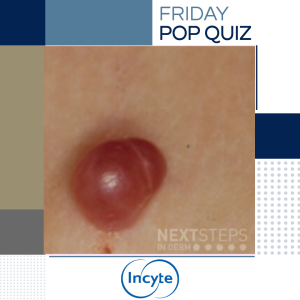
The correct answer is E. Pregnancy.
This is a pyogenic granuloma. In pregnancy, the lesion occurs most frequently over the buccal mucosa and gingivae.
Pyogenic granulomas commonly appear within the nail apparatus, where they may be periungual or subungual, and often follow penetrating trauma. Other common causes of pyogenic granuloma of the nail include ingrown toenails, systemic drugs (e.g. retinoids, EGFR inhibitors), peripheral nerve damage, and frictional onycholysis due to prolonged walking. Multiple periungual pyogenic granulomas occur most frequently in association with medications (reports suggest up to 30% of these are associated with medications) but are also seen in association with other chronic dermatoses such as atopic dermatitis and psoriasis. Disseminated pyogenic granulomas, although rare, have been documented to occur either spontaneously or after trauma, such as burns. Certain medications are also implicated, including isotretinoin use in patients with severe nodulocystic acne and the use of granulocyte colony-stimulating factor (G-CSF) in immunodeficient patients. Intraoral pyogenic granuloma appears to have a predilection for immunosuppressed patients, most often after a hematopoietic stem cell transplant.
References:
Piraccini BM, Bellavista S, Misciali C, et al. Periungual and subungual pyogenic granuloma. Br J Dermatol. 2010;163:941–953. PMID: 20545691; Sarwal P, Lapumnuaypol K. Pyogenic Granuloma. [Updated 2022 Oct 23]. In: StatPearls [Internet]. Treasure Island (FL): StatPearls Publishing; 2023 Jan-. Available from: https://www.ncbi.nlm.nih.gov/books/NBK556077/
